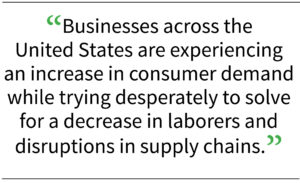“Economists and industry experts promise it’s not all doom and gloom.”
![]()

By Brittney Sherman

Brittney Sherman
You can’t drive down a street with businesses in Morgan Hill without coming across a “NOW HIRING” sign. If you haven’t experienced it already, you plan to visit a restaurant or shop at a retail store only to discover they have reduced their hours of operation due to staffing limitations. Businesses across the United States are experiencing an increase in consumer demand while trying desperately to solve for a decrease in laborers and disruptions in supply chains.
Small businesses are the backbone of our economy, providing employment for more than seven million Californians. According to data collected by Small Business Majority, 60 percent of small business owners who laid off employees have been unable to restore their staff to pre-pandemic levels.
Labor scarcity is plaguing every industry and resulted in an all-time record 8.3 million job openings in April. The Associated Press reports that the state’s restaurant industry remains about 450,000 jobs below its pre-pandemic level. And there’s not just a shortage of cooks, bartenders and food servers — many sectors are struggling to fill jobs too, including construction, home health care, retail and transportation/deliveries.

Photo courtesy Lori Allen
As the country slowly gets back on its feet following the global pandemic, many businesses in Morgan Hill are looking for workers, including Toray Advanced Composites.
What’s fueling the trend in labor scarcity? Factors range from extended unemployment benefits to the rise in the Delta Variant cases to a re-evaluation of the work-life balance.
Sadly, small business owners who weathered the pandemic are the ones most affected, desperately searching for workers to keep their business operational but not being able to compete with the pay, incentives and benefits large corporations are currently offering.
Industries are also experiencing shortages in key raw materials. This scarcity of raw materials is reverberating across supply chains as these commodities are often not only end products in and of themselves, but are part of other products as well.
Acute shortages in lumber, steel and cement are pushing the price of remodeling projects and home construction through the roof, further straining construction budgets and resulting in increased home sale prices.
Economists and industry experts promise it’s not all doom and gloom. They anticipate supply chains will “catch-up” and resume normal operations within the next six-months and that the beginning stages of workforce recovery have already started in June where the United States added 850,000 workers back into the workforce, the highest gain in 10 months.
 While the economy and workforce begin to re-balance, your food may take a little longer, your hotel room might not be ready on time and you might pay a few extra dollars for that boutique store shirt.
While the economy and workforce begin to re-balance, your food may take a little longer, your hotel room might not be ready on time and you might pay a few extra dollars for that boutique store shirt.
In light of the consumer demand, staffing and supply chain challenges, please treat Morgan Hill businesses with the patience, support and understanding they deserve.








